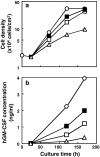Effects of heat treatment and concentration of fish serum on cell growth in adhesion culture of Chinese hamster ovary cells
- PMID: 19484373
- PMCID: PMC2698441
- DOI: 10.1007/s10616-009-9199-7
Effects of heat treatment and concentration of fish serum on cell growth in adhesion culture of Chinese hamster ovary cells
Abstract
The effects of heat treatment and concentration of fish serum (FS) on cell growth and human granulocyte-macrophage colony-stimulating factor (hGM-CSF) production in an adhesion culture of recombinant Chinese hamster ovary (CHO) cells, DR1000L4N, were investigated. The addition of heat treated FS instead of non-heat-treated FS improved cell growth in terms of cell density, which reached 60% that in 10% fetal calf serum (FCS)-containing medium (FCS medium). A decrease in FS concentration from 10 to 1.25% markedly increased cell density, which was 79% that in 10% FCS medium. The combination of heat treatment at 56 degrees C and the addition of FS at a low concentration (1.25%) showed an additive effect on cell growth and resulted in the same cell density as that in 10% FCS medium, whereas the hGM-CSF concentration in the culture using FS-containing medium (FS medium) was approximately 50% that in 10% FCS medium. The total lipid concentration in FS was more than three fold that in FCS. The effect of decreasing FS concentration on cell growth may be due to the low lipid concentration in FS medium, because addition of the lipids extracted from FS to 10% FCS and 1.25% FS media markedly decreased cell density. Consequently, the addition of heat-treated FS at low concentrations to medium may be useful for the growth of CHO cells without FCS.
Figures






Similar articles
-
Fetal calf serum-free culture of Chinese hamster ovary cells employing fish serum.Appl Microbiol Biotechnol. 2007 Jul;75(5):983-7. doi: 10.1007/s00253-007-0897-9. Epub 2007 Mar 3. Appl Microbiol Biotechnol. 2007. PMID: 17334756
-
Fetal calf serum-free suspension culture of Chinese hamster ovary cells employing fish serum.J Biosci Bioeng. 2010 Mar;109(3):307-9. doi: 10.1016/j.jbiosc.2009.08.481. Epub 2009 Sep 16. J Biosci Bioeng. 2010. PMID: 20159583
-
Modulation of human cord blood progenitor cell growth by recombinant human interleukin 3 (IL-3), IL-6, granulocyte-macrophage colony stimulating factor (GM-CSF) and stem cell factor (SCF) in serum-supplemented and serum-free medium.Stem Cells. 1994 Nov;12(6):616-25. doi: 10.1002/stem.5530120609. Stem Cells. 1994. PMID: 7533580
-
Culture of ovine bone marrow-derived macrophages and evidence for serum factors distinct from M-CSF contributing to their propagation in vitro.J Leukoc Biol. 1992 Jun;51(6):525-34. doi: 10.1002/jlb.51.6.525. J Leukoc Biol. 1992. PMID: 1613390
-
Optimizing Wnt activation in fetal calf serum (FCS)-free organoid expansion media.Front Toxicol. 2025 May 14;7:1504469. doi: 10.3389/ftox.2025.1504469. eCollection 2025. Front Toxicol. 2025. PMID: 40438536 Free PMC article. Review.
Cited by
-
Xeno-free proliferation of human bone marrow mesenchymal stem cells.Cytotechnology. 2012 May;64(3):301-8. doi: 10.1007/s10616-011-9400-7. Epub 2011 Oct 15. Cytotechnology. 2012. PMID: 22002865 Free PMC article.
-
Characterization of in vitro cultured myoblasts isolated from duck (Anas platyrhynchos) embryo.Cytotechnology. 2011 Aug;63(4):399-406. doi: 10.1007/s10616-011-9356-7. Epub 2011 May 26. Cytotechnology. 2011. PMID: 21614608 Free PMC article.
-
Investigations to extend viability of a rainbow trout primary gill cell culture.Ecotoxicology. 2017 Dec;26(10):1314-1326. doi: 10.1007/s10646-017-1856-6. Epub 2017 Nov 11. Ecotoxicology. 2017. PMID: 29127661
References
-
- {'text': '', 'ref_index': 1, 'ids': [{'type': 'DOI', 'value': '10.1007/s00253-007-0897-9', 'is_inner': False, 'url': 'https://doi.org/10.1007/s00253-007-0897-9'}, {'type': 'PubMed', 'value': '17334756', 'is_inner': True, 'url': 'https://pubmed.ncbi.nlm.nih.gov/17334756/'}]}
- Fujiwara M, Tsukada R, Tsujinaga Y, Takagi M (2007) Fetal calf serum-free culture of Chinese hamster ovary cells employing fish serum. Appl Microbiol Biotechnol 75:983–987. doi:10.1007/s00253-007-0897-9 - PubMed
-
- {'text': '', 'ref_index': 1, 'ids': [{'type': 'DOI', 'value': '10.1677/joe.0.120R019', 'is_inner': False, 'url': 'https://doi.org/10.1677/joe.0.120r019'}, {'type': 'PubMed', 'value': '2926294', 'is_inner': True, 'url': 'https://pubmed.ncbi.nlm.nih.gov/2926294/'}]}
- Funkenstein B, Silgergeld A, Cavari B, Laron Z (1989) Growth hormone increases plasma levels of insulin-like growth factor (IGF-I) in a teleost, the gilthead seabream (Sparus aurata). J Endocrinol 120:R19–R21. doi:10.1677/joe.0.120R019 - PubMed
-
- {'text': '', 'ref_index': 1, 'ids': [{'type': 'DOI', 'value': '10.1074/jbc.272.11.7285', 'is_inner': False, 'url': 'https://doi.org/10.1074/jbc.272.11.7285'}, {'type': 'PubMed', 'value': '9054425', 'is_inner': True, 'url': 'https://pubmed.ncbi.nlm.nih.gov/9054425/'}]}
- Hata J-I, Takeo J, Segawa C, Yamashita S (1997) A cDNA encoding fish fibroblast growth factor-2, which lacks alternative translation initiation. J Biol Chem 272:7285–7289. doi:10.1074/jbc.272.11.7285 - PubMed
-
- {'text': '', 'ref_index': 1, 'ids': [{'type': 'DOI', 'value': '10.1006/gcen.2001.7677', 'is_inner': False, 'url': 'https://doi.org/10.1006/gcen.2001.7677'}, {'type': 'PubMed', 'value': '11589631', 'is_inner': True, 'url': 'https://pubmed.ncbi.nlm.nih.gov/11589631/'}]}
- Larsen DA, Beckman BR, Dickhoff WW (2001) The effect of low temperature and fasting during the winter on metabolic stores and endocrine physiology (insulin, insulin-like growth factor-I, and thyroxine) of coho salmon, Oncorhynchus kisutch. Gen Comp Endocrinol 123:308–323. doi:10.1006/gcen.2001.7677 - PubMed
-
- {'text': '', 'ref_index': 1, 'ids': [{'type': 'DOI', 'value': '10.1016/j.aquaculture.2005.05.030', 'is_inner': False, 'url': 'https://doi.org/10.1016/j.aquaculture.2005.05.030'}]}
- Nordgarden U, Hansen T, Hemre G-I, Sundby A, Bjornsson BT (2005) Endocrine growth regulation of adult Atlantic salmon in seawater: the effect of light regime on plasma growth hormone, insulin-like growth factor-I, and insulin levels. Aquaculture 250:862–871. doi:10.1016/j.aquaculture.2005.05.030
LinkOut - more resources
Full Text Sources

